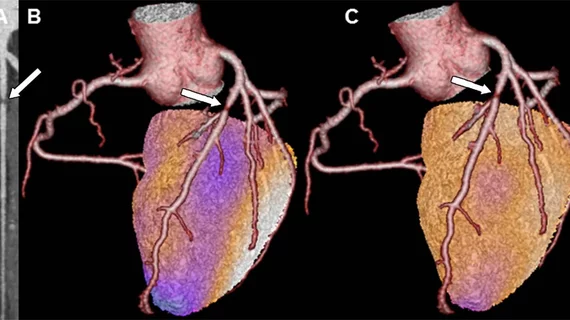Hybrid cardiac imaging may improve prediction of heart attack risk
For patients evaluated for coronary artery disease, research published July 3 in Radiology suggests that cardiac hybrid imaging with CT imaging and nuclear stress testing may be an effective predictor of heart attack risk and other adverse cardiac events.
The findings may improve determining stenosis more precisely than standard invasive coronary angiography techniques, which can vary in accurately predicting heart attack risk and offers scarce information regarding perfusion, wrote coauthor Philipp A. Kaufmann, MD, director of cardiac imaging at University Hospital Zurich in Switzerland, and colleagues.
"In patients with multiple lesions or complex coronary anatomy, it is, in many cases, very difficult to correctly identify the culprit lesion," Kaufmann said in a statement. "In a previous multicenter trial, with hybrid imaging we were able to see that about one in five patients should be revascularized in another coronary artery than originally planned."
To collect information on stenosis and perfusion, researchers analyzed 428 participants who underwent cardiac hybrid imaging—combining coronary computed tomography angiography (CCTA) and myocardial perfusion imaging with single photon emission tomography (SPECT).
While conducting an average follow-up of about seven years, the researchers recorded a total of 160 major adverse cardiac events, including 45 deaths.
Patients with stenosis of 50 percent or more on CCTA with evidence of ischemia on SPECT had more than five times the risk of adverse events than those with normal findings, Kaufmann and colleagues wrote. Comparatively, patients with evidence of ischemia but not in the area of the heart being fed by the stenotic artery had three times the risk of adverse events.
The findings support the use of CCTA as a noninvasive evaluation of patients with known or suspected CAD. If results were normal, individuals would require no additional imaging, the researchers wrote.
"If a lesion was evident, then clinicians could employ a nuclear scan to assess ischemia and take advantage of both modalities by fusing the results together to make a hybrid image," according to an Radiological Soceity of North America (RSNA) press release.

